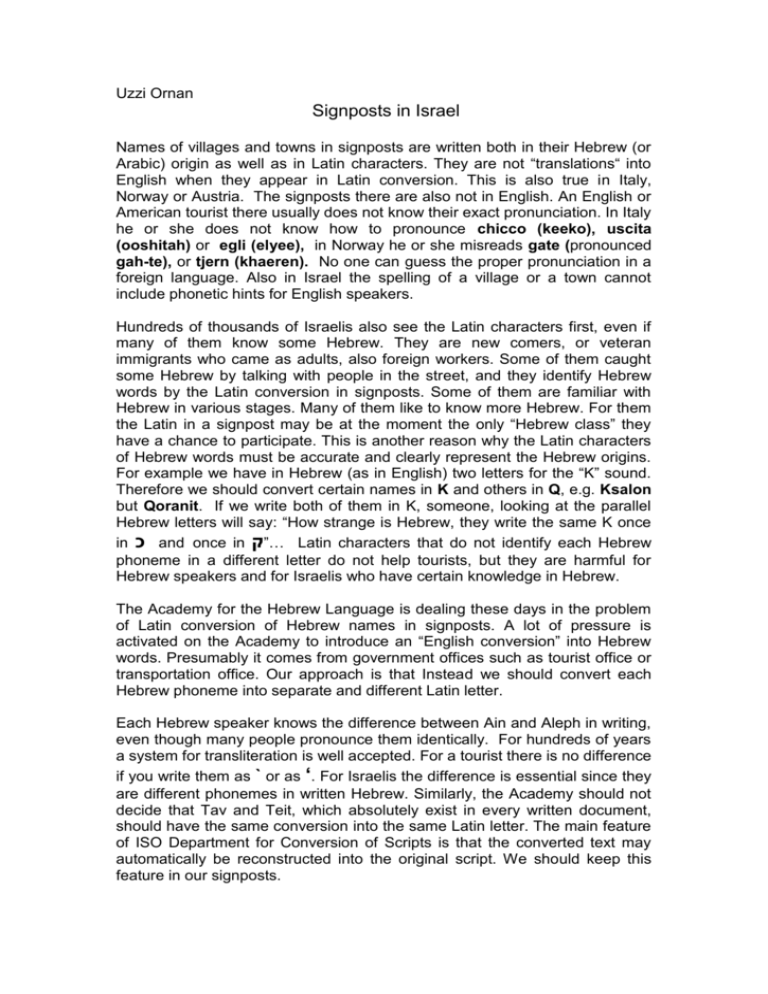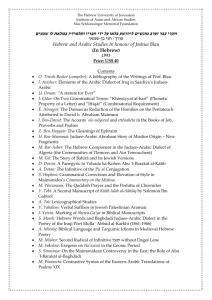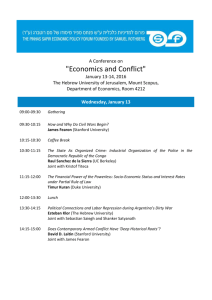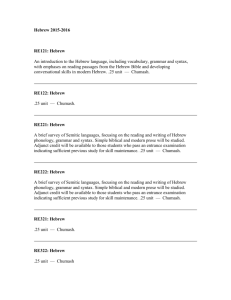JP signposts
advertisement

Uzzi Ornan Signposts in Israel Names of villages and towns in signposts are written both in their Hebrew (or Arabic) origin as well as in Latin characters. They are not “translations“ into English when they appear in Latin conversion. This is also true in Italy, Norway or Austria. The signposts there are also not in English. An English or American tourist there usually does not know their exact pronunciation. In Italy he or she does not know how to pronounce chicco )keeko(, uscita (ooshitah) or egli (elyee), in Norway he or she misreads gate (pronounced gah-te), or tjern (khaeren). No one can guess the proper pronunciation in a foreign language. Also in Israel the spelling of a village or a town cannot include phonetic hints for English speakers. Hundreds of thousands of Israelis also see the Latin characters first, even if many of them know some Hebrew. They are new comers, or veteran immigrants who came as adults, also foreign workers. Some of them caught some Hebrew by talking with people in the street, and they identify Hebrew words by the Latin conversion in signposts. Some of them are familiar with Hebrew in various stages. Many of them like to know more Hebrew. For them the Latin in a signpost may be at the moment the only “Hebrew class” they have a chance to participate. This is another reason why the Latin characters of Hebrew words must be accurate and clearly represent the Hebrew origins. For example we have in Hebrew (as in English) two letters for the “K” sound. Therefore we should convert certain names in K and others in Q, e.g. Ksalon but Qoranit. If we write both of them in K, someone, looking at the parallel Hebrew letters will say: “How strange is Hebrew, they write the same K once in כand once in …”קLatin characters that do not identify each Hebrew phoneme in a different letter do not help tourists, but they are harmful for Hebrew speakers and for Israelis who have certain knowledge in Hebrew. The Academy for the Hebrew Language is dealing these days in the problem of Latin conversion of Hebrew names in signposts. A lot of pressure is activated on the Academy to introduce an “English conversion” into Hebrew words. Presumably it comes from government offices such as tourist office or transportation office. Our approach is that Instead we should convert each Hebrew phoneme into separate and different Latin letter. Each Hebrew speaker knows the difference between Ain and Aleph in writing, even though many people pronounce them identically. For hundreds of years a system for transliteration is well accepted. For a tourist there is no difference if you write them as ` or as ‘. For Israelis the difference is essential since they are different phonemes in written Hebrew. Similarly, the Academy should not decide that Tav and Teit, which absolutely exist in every written document, should have the same conversion into the same Latin letter. The main feature of ISO Department for Conversion of Scripts is that the converted text may automatically be reconstructed into the original script. We should keep this feature in our signposts. Another principle for Hebrew converted into Latin is that each Hebrew phoneme should be converted into one letter only, not a combination of two. “h” cannot be an “auxiliary sign” in Hebrew conversion. Italian does not have the phoneme /h/, nor the phone [h]. In English the phoneme /h/ only comes at the beginning of a word or following a vowel. Therefore in Italian or in English “h” can be used as an auxiliary sign such as ch, sh, zh or kh. But in Hebrew the phoneme /h/ is a regular one. The solution should be – as in most European languages – using of diacritics. (See examples at the end of this article.) There is a third point. G and C in English and many other languages have each two pronunciations. Still, there is one letter for both of them. The reader knows how to pronounce them according to their position in the word. Hebrew also has letters that have each two pronunciations. They are B, P, and K, which sometimes have the phonetic value of V, F and Spanish X, respectively. Hebrew speakers know how to pronounce them properly. When we always keep them in writing as B, P, an K only, we gain a lot of language understanding. For the signposts we suggest however that small diacritic signs should be added when it is the other pronunciation (see examples). It is essential for us to know what the “main consumers” of the Latin signpost think. Many of them are probably readers of this paper. The view that we defend as proper is that no nation should distort the elements of its language in order to “facilitate” tourists to pronounce words. Please look at the examples and think if a tourist will be lost when he or she have the following signposts. New conversion of the Academy recommended conversion NEVE AVOT NEVE A®OT BE'ER SHEVA BE`ER £E®A΄ SHKHANYA £°ANYA Original Hebrew נְ וֵה אָ בֹות בְ אֵ ר שֶ בַ ע ְשכַנְ יָה









